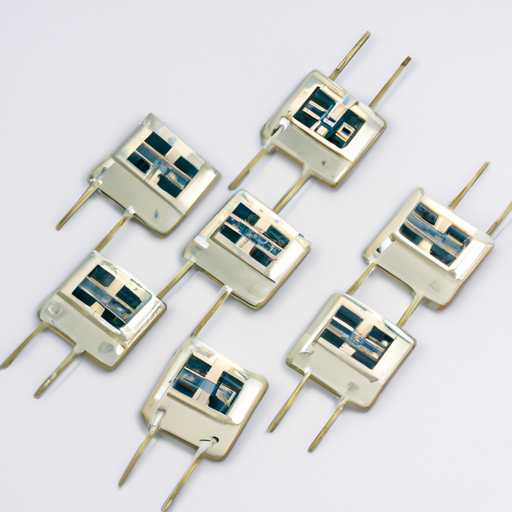What are the Product Features of Neutral Point Grounding Resistors?

I. Introduction
A. Definition of Neutral Point Grounding Resistors
Neutral Point Grounding Resistors (NPGRs) are essential components in electrical systems, particularly in three-phase power systems. They are used to connect the neutral point of a transformer or generator to the ground through a resistor. This connection helps to manage fault currents and stabilize the system during electrical faults.
B. Importance of Grounding in Electrical Systems
Grounding is a critical aspect of electrical engineering, ensuring safety and reliability in power systems. It provides a reference point for voltage levels, protects equipment from overvoltages, and facilitates the safe dissipation of fault currents. Proper grounding minimizes the risk of electrical shock, equipment damage, and system failures.
C. Purpose of the Article
This article aims to explore the key product features of Neutral Point Grounding Resistors, highlighting their importance in electrical systems and their functional benefits.
II. Overview of Neutral Point Grounding
A. Explanation of Neutral Point Grounding
Neutral Point Grounding involves connecting the neutral point of a power system to the ground. This connection can be achieved through various methods, including solid grounding, resistance grounding, and reactance grounding. Each method has its advantages and applications, depending on the specific requirements of the electrical system.
B. Types of Grounding Systems
1. **Solid Grounding**: In solid grounding, the neutral point is directly connected to the ground without any impedance. This method provides a low-resistance path for fault currents but can lead to high fault currents that may damage equipment.
2. **Resistance Grounding**: This method uses a resistor to connect the neutral point to the ground. It limits the fault current to a predetermined level, reducing the risk of equipment damage while maintaining system stability.
3. **Reactance Grounding**: Reactance grounding employs inductors to connect the neutral point to the ground. This method limits fault currents and provides a degree of voltage stabilization.
C. Role of Neutral Point Grounding Resistors in Electrical Systems
Neutral Point Grounding Resistors play a crucial role in resistance grounding systems. They limit the magnitude of fault currents, enhance system stability, and protect equipment from damage during electrical faults. By providing a controlled path for fault currents, NPGRs contribute to the overall safety and reliability of electrical systems.
III. Key Features of Neutral Point Grounding Resistors
A. Resistance Value
1. **Importance of Resistance Value**: The resistance value of an NPGR is critical in determining the maximum fault current that can flow during a fault condition. A properly selected resistance value ensures that the fault current remains within safe limits, protecting equipment and personnel.
2. **Selection Criteria for Resistance Value**: The selection of resistance value depends on various factors, including system voltage, fault current levels, and equipment ratings. Engineers must carefully analyze these factors to choose the appropriate resistance value for optimal performance.
B. Power Rating
1. **Definition of Power Rating**: The power rating of an NPGR indicates the maximum amount of power it can dissipate without overheating. It is typically expressed in watts (W) or kilowatts (kW).
2. **Impact on System Performance**: A higher power rating allows the resistor to handle larger fault currents without failure. This capability is essential for maintaining system stability and preventing equipment damage during fault conditions.
C. Temperature Rating
1. **Importance of Temperature Rating**: The temperature rating of an NPGR indicates the maximum operating temperature it can withstand. Exceeding this temperature can lead to resistor failure and compromise system safety.
2. **Materials Used and Their Thermal Properties**: NPGRs are typically constructed from materials with high thermal conductivity and resistance to thermal degradation. Common materials include stainless steel and aluminum, which provide durability and reliability under varying temperature conditions.
D. Insulation Class
1. **Definition and Importance of Insulation Class**: The insulation class of an NPGR refers to its ability to withstand electrical stress without breaking down. It is crucial for ensuring the safety and reliability of the grounding system.
2. **Common Insulation Classes for Grounding Resistors**: Insulation classes are categorized based on temperature ratings, such as Class A (up to 105°C), Class B (up to 130°C), and Class F (up to 155°C). Selecting the appropriate insulation class is vital for ensuring long-term performance.
E. Physical Dimensions and Design
1. **Size and Form Factor**: The physical dimensions of NPGRs vary based on their power rating and application. Compact designs are often preferred for limited space installations, while larger units may be used in industrial settings.
2. **Mounting Options and Configurations**: NPGRs can be mounted in various configurations, including vertical, horizontal, or rack-mounted designs. The choice of mounting option depends on the installation environment and space constraints.
F. Durability and Environmental Resistance
1. **Protection Against Environmental Factors**: NPGRs must be designed to withstand harsh environmental conditions, including moisture, dust, and temperature fluctuations. Proper sealing and protective coatings enhance their durability.
2. **Compliance with Industry Standards**: Many NPGRs are designed to meet industry standards, such as IEC and ANSI, ensuring their reliability and safety in various applications.
G. Testing and Certification
1. **Importance of Testing for Safety and Reliability**: Rigorous testing is essential to ensure that NPGRs perform as expected under fault conditions. Testing includes thermal, electrical, and mechanical assessments.
2. **Common Certifications and Standards**: NPGRs may carry certifications from recognized organizations, such as UL, CE, and ISO, indicating compliance with safety and performance standards.
IV. Functional Features of Neutral Point Grounding Resistors
A. Limiting Fault Currents
1. **Mechanism of Fault Current Limiting**: NPGRs limit fault currents by providing a controlled resistance path to ground. This mechanism reduces the magnitude of fault currents, preventing excessive damage to equipment.
2. **Benefits of Limiting Fault Currents**: By limiting fault currents, NPGRs enhance system safety, reduce the risk of equipment failure, and minimize downtime during maintenance and repairs.
B. Enhancing System Stability
1. **Role in Voltage Stabilization**: NPGRs help stabilize voltage levels during fault conditions, preventing voltage spikes that can damage sensitive equipment.
2. **Impact on System Performance During Fault Conditions**: By maintaining voltage stability, NPGRs contribute to the overall performance and reliability of electrical systems during fault events.
C. Reducing Equipment Damage
1. **Mechanisms of Damage During Faults**: Electrical faults can cause excessive currents and voltages that lead to equipment overheating, insulation breakdown, and physical damage.
2. **How Resistors Mitigate Damage**: NPGRs mitigate damage by limiting fault currents and providing a safe path for excess energy to dissipate, protecting equipment from catastrophic failures.
D. Facilitating Maintenance and Safety
1. **Importance of Safe Maintenance Practices**: Proper grounding is essential for safe maintenance practices in electrical systems. NPGRs ensure that fault currents are managed effectively, reducing risks during maintenance activities.
2. **Features that Enhance Safety**: Features such as thermal protection, robust insulation, and compliance with safety standards enhance the safety of NPGRs, making them reliable components in electrical systems.
V. Applications of Neutral Point Grounding Resistors
A. Industrial Power Systems
NPGRs are widely used in industrial power systems to manage fault currents and enhance system stability. They are essential in manufacturing facilities, processing plants, and other industrial environments.
B. Renewable Energy Systems
In renewable energy systems, such as wind and solar power, NPGRs play a crucial role in grounding and protecting inverters and transformers, ensuring safe and reliable operation.
C. Utility Power Distribution
Utility companies utilize NPGRs in power distribution networks to manage fault currents and maintain system reliability, ensuring a stable power supply to consumers.
D. Data Centers and Critical Infrastructure
Data centers and critical infrastructure rely on NPGRs to protect sensitive equipment from electrical faults, ensuring uninterrupted operation and data integrity.
VI. Conclusion
A. Summary of Key Features
Neutral Point Grounding Resistors are vital components in electrical systems, offering features such as resistance value, power rating, temperature rating, insulation class, durability, and testing certifications. These features ensure their effectiveness in managing fault currents and enhancing system stability.
B. Importance of Selecting the Right Neutral Point Grounding Resistor
Choosing the appropriate NPGR is crucial for optimizing system performance and ensuring safety. Engineers must consider various factors, including resistance value, power rating, and environmental conditions, to select the right resistor for their specific application.
C. Future Trends in Grounding Technology
As electrical systems evolve, advancements in grounding technology will continue to emerge. Innovations in materials, design, and testing methods will enhance the performance and reliability of Neutral Point Grounding Resistors, ensuring their continued importance in modern electrical systems.
VII. References
A comprehensive list of sources and further reading can be provided to support the information presented in this article, including industry standards, technical papers, and manufacturer specifications.
---
This blog post provides an in-depth exploration of the product features of Neutral Point Grounding Resistors, emphasizing their significance in electrical systems and their functional benefits. By understanding these features, engineers and technicians can make informed decisions when selecting and implementing NPGRs in various applications.
What are the Product Features of Neutral Point Grounding Resistors?

I. Introduction
A. Definition of Neutral Point Grounding Resistors
Neutral Point Grounding Resistors (NPGRs) are essential components in electrical systems, particularly in three-phase power systems. They are used to connect the neutral point of a transformer or generator to the ground through a resistor. This connection helps to manage fault currents and stabilize the system during electrical faults.
B. Importance of Grounding in Electrical Systems
Grounding is a critical aspect of electrical engineering, ensuring safety and reliability in power systems. It provides a reference point for voltage levels, protects equipment from overvoltages, and facilitates the safe dissipation of fault currents. Proper grounding minimizes the risk of electrical shock, equipment damage, and system failures.
C. Purpose of the Article
This article aims to explore the key product features of Neutral Point Grounding Resistors, highlighting their importance in electrical systems and their functional benefits.
II. Overview of Neutral Point Grounding
A. Explanation of Neutral Point Grounding
Neutral Point Grounding involves connecting the neutral point of a power system to the ground. This connection can be achieved through various methods, including solid grounding, resistance grounding, and reactance grounding. Each method has its advantages and applications, depending on the specific requirements of the electrical system.
B. Types of Grounding Systems
1. **Solid Grounding**: In solid grounding, the neutral point is directly connected to the ground without any impedance. This method provides a low-resistance path for fault currents but can lead to high fault currents that may damage equipment.
2. **Resistance Grounding**: This method uses a resistor to connect the neutral point to the ground. It limits the fault current to a predetermined level, reducing the risk of equipment damage while maintaining system stability.
3. **Reactance Grounding**: Reactance grounding employs inductors to connect the neutral point to the ground. This method limits fault currents and provides a degree of voltage stabilization.
C. Role of Neutral Point Grounding Resistors in Electrical Systems
Neutral Point Grounding Resistors play a crucial role in resistance grounding systems. They limit the magnitude of fault currents, enhance system stability, and protect equipment from damage during electrical faults. By providing a controlled path for fault currents, NPGRs contribute to the overall safety and reliability of electrical systems.
III. Key Features of Neutral Point Grounding Resistors
A. Resistance Value
1. **Importance of Resistance Value**: The resistance value of an NPGR is critical in determining the maximum fault current that can flow during a fault condition. A properly selected resistance value ensures that the fault current remains within safe limits, protecting equipment and personnel.
2. **Selection Criteria for Resistance Value**: The selection of resistance value depends on various factors, including system voltage, fault current levels, and equipment ratings. Engineers must carefully analyze these factors to choose the appropriate resistance value for optimal performance.
B. Power Rating
1. **Definition of Power Rating**: The power rating of an NPGR indicates the maximum amount of power it can dissipate without overheating. It is typically expressed in watts (W) or kilowatts (kW).
2. **Impact on System Performance**: A higher power rating allows the resistor to handle larger fault currents without failure. This capability is essential for maintaining system stability and preventing equipment damage during fault conditions.
C. Temperature Rating
1. **Importance of Temperature Rating**: The temperature rating of an NPGR indicates the maximum operating temperature it can withstand. Exceeding this temperature can lead to resistor failure and compromise system safety.
2. **Materials Used and Their Thermal Properties**: NPGRs are typically constructed from materials with high thermal conductivity and resistance to thermal degradation. Common materials include stainless steel and aluminum, which provide durability and reliability under varying temperature conditions.
D. Insulation Class
1. **Definition and Importance of Insulation Class**: The insulation class of an NPGR refers to its ability to withstand electrical stress without breaking down. It is crucial for ensuring the safety and reliability of the grounding system.
2. **Common Insulation Classes for Grounding Resistors**: Insulation classes are categorized based on temperature ratings, such as Class A (up to 105°C), Class B (up to 130°C), and Class F (up to 155°C). Selecting the appropriate insulation class is vital for ensuring long-term performance.
E. Physical Dimensions and Design
1. **Size and Form Factor**: The physical dimensions of NPGRs vary based on their power rating and application. Compact designs are often preferred for limited space installations, while larger units may be used in industrial settings.
2. **Mounting Options and Configurations**: NPGRs can be mounted in various configurations, including vertical, horizontal, or rack-mounted designs. The choice of mounting option depends on the installation environment and space constraints.
F. Durability and Environmental Resistance
1. **Protection Against Environmental Factors**: NPGRs must be designed to withstand harsh environmental conditions, including moisture, dust, and temperature fluctuations. Proper sealing and protective coatings enhance their durability.
2. **Compliance with Industry Standards**: Many NPGRs are designed to meet industry standards, such as IEC and ANSI, ensuring their reliability and safety in various applications.
G. Testing and Certification
1. **Importance of Testing for Safety and Reliability**: Rigorous testing is essential to ensure that NPGRs perform as expected under fault conditions. Testing includes thermal, electrical, and mechanical assessments.
2. **Common Certifications and Standards**: NPGRs may carry certifications from recognized organizations, such as UL, CE, and ISO, indicating compliance with safety and performance standards.
IV. Functional Features of Neutral Point Grounding Resistors
A. Limiting Fault Currents
1. **Mechanism of Fault Current Limiting**: NPGRs limit fault currents by providing a controlled resistance path to ground. This mechanism reduces the magnitude of fault currents, preventing excessive damage to equipment.
2. **Benefits of Limiting Fault Currents**: By limiting fault currents, NPGRs enhance system safety, reduce the risk of equipment failure, and minimize downtime during maintenance and repairs.
B. Enhancing System Stability
1. **Role in Voltage Stabilization**: NPGRs help stabilize voltage levels during fault conditions, preventing voltage spikes that can damage sensitive equipment.
2. **Impact on System Performance During Fault Conditions**: By maintaining voltage stability, NPGRs contribute to the overall performance and reliability of electrical systems during fault events.
C. Reducing Equipment Damage
1. **Mechanisms of Damage During Faults**: Electrical faults can cause excessive currents and voltages that lead to equipment overheating, insulation breakdown, and physical damage.
2. **How Resistors Mitigate Damage**: NPGRs mitigate damage by limiting fault currents and providing a safe path for excess energy to dissipate, protecting equipment from catastrophic failures.
D. Facilitating Maintenance and Safety
1. **Importance of Safe Maintenance Practices**: Proper grounding is essential for safe maintenance practices in electrical systems. NPGRs ensure that fault currents are managed effectively, reducing risks during maintenance activities.
2. **Features that Enhance Safety**: Features such as thermal protection, robust insulation, and compliance with safety standards enhance the safety of NPGRs, making them reliable components in electrical systems.
V. Applications of Neutral Point Grounding Resistors
A. Industrial Power Systems
NPGRs are widely used in industrial power systems to manage fault currents and enhance system stability. They are essential in manufacturing facilities, processing plants, and other industrial environments.
B. Renewable Energy Systems
In renewable energy systems, such as wind and solar power, NPGRs play a crucial role in grounding and protecting inverters and transformers, ensuring safe and reliable operation.
C. Utility Power Distribution
Utility companies utilize NPGRs in power distribution networks to manage fault currents and maintain system reliability, ensuring a stable power supply to consumers.
D. Data Centers and Critical Infrastructure
Data centers and critical infrastructure rely on NPGRs to protect sensitive equipment from electrical faults, ensuring uninterrupted operation and data integrity.
VI. Conclusion
A. Summary of Key Features
Neutral Point Grounding Resistors are vital components in electrical systems, offering features such as resistance value, power rating, temperature rating, insulation class, durability, and testing certifications. These features ensure their effectiveness in managing fault currents and enhancing system stability.
B. Importance of Selecting the Right Neutral Point Grounding Resistor
Choosing the appropriate NPGR is crucial for optimizing system performance and ensuring safety. Engineers must consider various factors, including resistance value, power rating, and environmental conditions, to select the right resistor for their specific application.
C. Future Trends in Grounding Technology
As electrical systems evolve, advancements in grounding technology will continue to emerge. Innovations in materials, design, and testing methods will enhance the performance and reliability of Neutral Point Grounding Resistors, ensuring their continued importance in modern electrical systems.
VII. References
A comprehensive list of sources and further reading can be provided to support the information presented in this article, including industry standards, technical papers, and manufacturer specifications.
---
This blog post provides an in-depth exploration of the product features of Neutral Point Grounding Resistors, emphasizing their significance in electrical systems and their functional benefits. By understanding these features, engineers and technicians can make informed decisions when selecting and implementing NPGRs in various applications.













